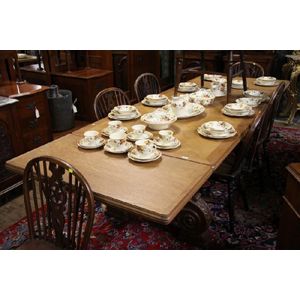Rosewood Ladies Bonheur de Jour with Inlaid Design
A French inlaid rosewood ladies Bonheur de jour on mounted cabriole legs with fitted interior and bombe shaped fall, top & sides.
You must be a subscriber, and be logged in to view price and dealer details.
Subscribe Now to view actual auction price for this item
When you subscribe, you have the option of setting the currency in which to display prices to $Au, $US, $NZ or Stg.
This item has been sold, and the description, image and price are for reference purposes only.
- Inlay - Decorative patterns inserted into the main body of a piece of furniture, generally in wood of contrasting colour and grain, though brass, ivory, ebony, shell and sometimes horn have been used. Inlay may consist of a panel of well figured timber inset into a cabinet door front, geometric patterns, or complex and stylized designs of flowers, swags of foliage, fruits and other motifs. As a general rule, in pieces where the carcase is constructed in the solid, the inlay is relatively simple such as stringing, cross banding and herringbone banding. Where more elaborate and decorative work was required veneer was used. Inlay has been fashionable from at least the latter half of the 17th century, when a variety of elaborate forms were developed
- Rosewood - A dense timber that varies in shade to very light brown to almost black. When rosewood is cut and sanded the colour of the timber will turn black, and after polishing and exposure to daylight, the surface will gradually lighten over time to light brown with black streaks.
The name comes from the odour emanating from the timber when it is planed, sanded or cut.
Rosewood was very popular for use in Victorian furniture in the second half of the 19th century, and at that time most of the rosewood was imported from Brazil. However it also grows in India and Indonesia.
It is used in the sold for chairs and table legs, but for carcase furniture such as side cabinets and bookcases, and for table tops it is always used as a veneer. - Cabriole Leg - The cabriole leg evolved from an elongated scroll, curving out at the knee which may or may not be carved, and forming a serpentine shape as it descends to the foot.
First introduced into English furniture in the late 17th century, cabriole legs were widely used during the Queen Anne and early Georgian periods, where they frequently terminated in a pad foot or ball and claw foot. The style has had many imitators since then. The cabriole leg was re-introduced in the mid-19th century, and is commonly associated with the balloon-back dining or drawing-room chairs made in walnut, mahogany or, in Australia, cedar. The Victorian cabriole leg, on the whole, was rather more slender than the earlier form, following the French style, which emphasized the delicacy and daintiness of the chairs they were designed to support. Cabriole legs are sometimes found on windsor chairs, especially those made during the 18th century. - Bombe Front - More commonly associated with a dome shaped dessert, "bombe" in furniture parlance means "puffed out". In profile the piece is serpentine shaped, narrow at the top, swelling out towards the middle and continuing to the floor, though sometimes it narrowed again at the foot. Drawer fronts are curved in section. Bombe pieces are often highly decorated with marquetry inlay, or veneered and set with brass or ormolu mounts. The most common use of the word, is in the description of the 'bombe commode'.
The bombe design was particularly popular in the 18th century, during the reign of Louis XIV, when it was used to create furniture pieces with a curved, rounded bulging shape. This design was used on furniture in many styles, including Baroque, Louis XIV, Louis XV and Louis XVI. The bombe chest is one of the most iconic furniture piece featuring this design. They were usually made of precious woods like mahogany, rosewood, and walnut, and feature elaborate inlay, gilded ornaments and ormolu. Other items of furniture where the bombe design can be seen include cabinets, commodes, and desks.
This item has been included into following indexes:
-
desks, style or type
- bonheur du jour 51
- ladies 90
- table style 197
Visually similar items

A French oak parquetry top drawer leaf extension dining table, supported on a an ornately carved base
Sold by
in
for
You can display prices in $Au, $US, $NZ or Stg.

Fine pair of leather deep buttoned armchairs by 'Gascoigne'
Sold by
in
for
You can display prices in $Au, $US, $NZ or Stg.

A good Victorian etagere, with ornate scroll leaf and flower carving, 139 cm wide, 239 cm high approx
Sold by
in
for
You can display prices in $Au, $US, $NZ or Stg.

An early 18th century Georgian oval drop leaf table in oak with gate legs and turned supports and stretchers
Sold by
in
for
You can display prices in $Au, $US, $NZ or Stg.
